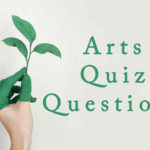100 Science Quiz Questions and Answers

1) Who was the first pre-Socratic philosopher to suggest that matter could neither be created nor destroyed?
Answer: Parmenides.
2) Which quantum number gives the shape of the orbital?
Answer: Azimuthal quantum number.
3) What is ecosystem?
Answer: The entire living community and non-living factors of the environment together from the ecosystem.
4) In 1729 AD, Pieter Van Musschenbroek used the term ‘PHYSICS’ for the first time. What was the subject called so far?
Answer: Natural philosophy.
5) What is the maximum capacity of d-orbital?
Answer: 10 electrons.
6) Which form of science dealing with the study of structural and cultural traits of human beings?
Answer: Anthropology.
7) Which Greek philosopher suggested that the material world was composed of four basic elements – air, water, fire and earth?
Answer: Empedocles.
8) What is the shape of s-orbital?
Answer: Spherical.
9) What are the two functional groups in an ecosystem?
Answer: Autotrophs and heterotrophs.
10) Who in 1231 was the first to describe the science of optics?
Answer: Robert Grosseteste.
11) What do you mean by Zeeman Effect?
Answer: Splitting of spectral lines by magnetic field.
12) Where does the primary photo chemical reaction occur in chloroplast?
Answer: Quantasome.
13) Who was burnt to death for suggesting that the sun might be an ordinary star?
Answer: Giordano Bruno.
14) What is the shape of p-orbital?
Answer: Dumb-bell.
15) What is exobiology?
Answer: It is the study of life in outer space.
16) Who in 1643 was the first person to create vacuum above the liquid?
Answer: Evangelista Torricelli.
17) Which series of hydrogen atomic spectrum lies in the visible region?
Answer: Balmer series.
18) What is the magnification of an electron microscope?
Answer: 100000.
19) Who in 1786 invented the gold leaf electro scope?
Answer: Abraham Bennet.
20) Who proposed elliptical orbits?
Answer: Sommerfeld.
21) Which is the monocarpic plant which shows gregarious flowering once in 48 years?
Answer: Bamboo.
22) Who encouraged Newton to write his idea for principia?
Answer: Edmund Halley.
23) How many atomic orbitals are known? What are they?
Answer: Four. S, p, d, and f.
24) Write an example of serendipity.
Answer: Discovery of penicillin by Fleming.
25) Who in 1808 discovered polarization of light and introduced the term ‘Polarization’?
Answer: Etienne-Louis Malus.
Science Quiz Questions and Answers Part 2
26) What is the maximum number of electrons that can be accommodated in an orbital?
Answer: 2.
27) What do you mean by Hydroponics?
Answer: Plant growth in liquid culture medium.
28) The first scientist to apply scientific reasoning to cosmology was Rene Descartes. What was his theory called?
Answer: Vortex Theory.
29) How many orbitals present 5f subshell?
Answer: Seven.
30) What is the technique of separation of disrupted cell components?
Answer: Fractionation.
31) In which year did Otto Von Guericke demonstrate his famous Magdeburg experiment dealing vacuum?
Answer: 1672.
32) On which property of electrons does the electron microscope work?
Answer: Wave nature.
33) What is EM?
Answer: Electron microscope.
34) Who was the first to attack Newton’s Corpuscular theory of light?
Answer: Thomas Young.
35) The element with the minimum atomic number having 8 electrons in the outer most shell is what?
Answer: Neon.
36) Name two monocarpic plants which show gregarious flowering.
Answer: Bambusa tulda, Melocanna bambusoides.
37) Who was the first person to design models of flying machine?
Answer: Leonardo da Vinci.
38) The s-orbital of the L shell is represented as what?
Answer: 2s.
39) Under what system, organisms are provided with scientific means?
Answer: Binomial nomenclature.
40) Who in 1749 developed a method for making an artificial magnet?
Answer: John canton.
41) What is the maximum number of electrons in principal energy level?
Answer: K-2, L-8, M-18, N-32.
42) What is the name of that branch of Biology which devoted to identifying, naming and classifying organisms?
Answer: Taxonomy.
43) Hydrodynamica gave explanation of Bernoulli’s theorem in 1738. Who was the first to suggest this theorem?
Answer: Daniel Bernoulli.
44) What is the atomic number of the element which has 3 electrons in its M shell?
Answer: 13.
45) Who was the author of ‘Man’s place in nature’?
Answer: Huxley.
46) Who invented Leyden jar?
Answer: Pieter Van Musschenbroek and Ewald Georg von Kleist.
47) Which atom has only one electron?
Answer: hydrogen.
48) Both living and the non-living are made of same elements and are governed by the similar physical laws. In which respect are they different?
Answer: Level organization.
49) Which famous Danish physicist in 1675 measured the speed of light?
Answer: Romer.
50) The path of the electron according to Niels Bohr’s theory was called what?
Answer: Orbit shell.
Science Quiz Questions and Answers Part 3
51) Expand the TMV.
Answer: Tobacco Mosaic Virus.
52) What did Sir William Herschel discover in 1800?
Answer: Infra-red radiation.
53) How many electrons can be accommodated in the M shell?
Answer: 18.
54) What is DNA?
Answer: Deoxyribonucleic acid.
55) In which year did G.S. Ohm formulate Ohm’s law?
Answer: 1827.
56) An electron jumps in to the next lower orbit when loses what?
Answer: One quantum of energy.
57) What is Histology?
Answer: Histology is the study of tissues (Microscopic anatomy).
58) In which year did A. Michelson and E. Morley conduct their experiment to verify the existence of ether?
Answer: 1887.
59) How many orbitals are there in p-subshell?
Answer: Three.
60) Which is the free living soil bacteria in fixes nitrogen?
Anatomy: Azotobacter.
61) Who in 1939 suggested the name meson for middle-weight particles?
Answer: Homi J. Bhabha.
62) The various orbitals of the same subshell will differ in what?
Answer: In their direction orientation.
63) What is Physiology?
Answer: Physiology is the study of structure and functions.
64) What is the importance of 2nd December 1942?
Answer: The creation of the first controlled chain reaction.
65) Electron is looked upon as a cloud of negative charge according to what?
Answer: Wave-mechanics theory.
66) What is Cell Biology?
Answer: Cell Biology is the study of structure and reproduction of cells.
67) Which philosopher conjectured that if the moon did not move, it would fall upon the earth?
Answer: Anaxagoras.
68) The subshell consisting of dumb-bell shaped orbitals is known as what?
Answer: P-subshell.
69) What do you mean by Genetics?
Answer: Genetics is the study of heredity and variations.
70) Who said, “A bird is an instrument working according to the mathematical laws”?
Answer: Leonardo da Vinci.
71) The region of space around the nucleus where there is a high probability of finding an electron is called what?
Answer: Orbital.
72) Write a Radio isotope.
Answer: I-131.
73) Who said, “All falling bodies, irrespective of their size, descend at the same speed”?
Answer: Galileo Galilei.
74) The major shell-wise electronic configuration of element with the atomic number 15 is what?
Answer: 2, 8, 5.
75) How does the living and non-living resemble up to the level organization?
Answer: Molecules and compounds.
Science Quiz Questions and Answers Part 4
76) Which Austrian physicist developed the philosophy that all knowledge is simply sensation?
Answer: Ernest Mach.
77) Who put forward the principle of uncertainty?
Answer: Werner Heisenberg.
78) What number of chemicals are present in a cell?
Answer: About 5000.
79) Who contemplated “A freely floating magnet orients itself in the north-south direction?
Answer: Robert Norman.
80) When electron leaves an orbital and jumps in to another?
Answer: When its energy changes.
81) Write an example of homeostasis.
Answer: Increased heart beat on running and sweating during exercise.
82) Who gave the idea “Electricity flows through space from heated metal”?
Answer: Thomas Alva Edison.
83) The electronic configuration of an atom is 2, 8, and 2. What is its atomic number?
Answer: 12.
84) Which is called blue-print of information?
Answer: DNA.
85) “Moving particles have wave characteristics.” Who proposed the idea first?
Answer: Victor de Broglie.
86) What do you mean by orbitals?
Answer: They are regions of space around the nucleus where the probability of finding an electron is maximum.
87) Which cells are programmed to die during embryonic stage?
Answer: Vessel elements.
88) Who suggested that light is made up of packets of energy known as protons?
Answer: Albert Einstein.
89) What are the integers used to express the energy, posit, etc. of an electron?
Answer: Quantum numbers.
90) Why virus cannot be cultured in totally artificial medium?
Answer: Because it lacks machinery to use genetic information.
91) Who first gave the concept of ‘Atom’?
Answer: Kanada.
92) The steady state from which no spontaneous change takes place is called what?
Answer: Equilibrium.
93) What are seedless plants called?
Answer: Cryptogams.
94) How many times is the proton heavier than the electron?
Answer: 1836 times.
95) What is the color of ammonium chloride?
Answer: White.
96) What is Dendrology?
Answer: The study of trees called Dendrology.
97) What is AMU?
Answer: It is the unit of atomic mass.
98) The chemical reactions which never go to completion are called what?
Answer: Reversible reactions.
99) Energy is converted from sunlight and released by what?
Answer: Respiration.
100) Which disease is spread in minute water drops?[CR][CR](Answer: two words.)
Answer: Legionnaire’s disease.
Read more > Quiz Questions and Answers


One Comment
Leave a Reply